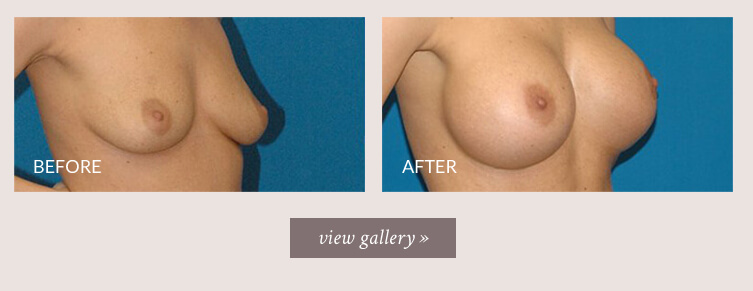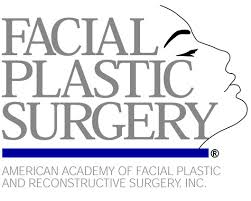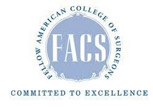Breast Augmentation
Breast augmentation is a procedure that enhances the volume and shape of the breast. Women choose augmentation for many different reasons. Some want to feel more feminine or improve self-confidence. They want to fill out their clothing, wear pretty bras that actually fit, be more comfortable in swim suits, evening wear or without clothing. They may want to feel more proportionate and balance out fuller hips or shoulders. Others want to restores breast volume that may have been lost after childbirth and breastfeeding or after significant weight loss.
With so many different reasons for considering it, breast augmentation is not surprisingly the world’s most popular cosmetic procedure, accounting for 15% of all cosmetic surgery annually. There were over 300,000 augmentation surgeries performed in the US last year.
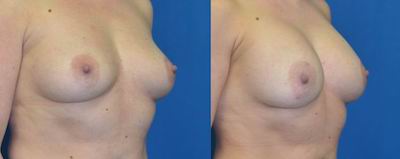
Breast augmentation with silicone breast implants Left: 280cc Right: 265cc . *Individual results may vary.
What can I expect at my consultation?
When you come in for your consultation, you will first meet with one of our Patient Care Coordinators (PCC) who will work with you throughout your entire experience. When Dr. Burnett meets you a few minutes later, she will want to get to know you.
She will ask you what type of 'look' you wish to achieve with your breast augmentation. Some patients prefer a very subtle, natural and proportional augmentation. They don’t want it to be obvious to others that they have had their breasts enhanced. Often, their goal is to look like they do in a padded bra without having to wear one. Other patients may desire a more 'augmented' look with rounded fullness in the upper breast and exaggerated cleavage. They are comfortable with others knowing that they have implants and may want to look like they have a push-up bra on when they aren’t wearing a bra at all.
Lifestyle will also be taken into consideration. With a good understanding of your individual situation and goals, Dr. Burnett can better guide you to appropriate choices for achieving the result you desire. She will also want to answer any questions you may have.
Next, she will carefully take several measurement that will serve as a guide to implant choice. If only a small volume change is your goal, fat grafting may also be an option. You will then “try on” some implants in front of a mirror so that you get a better feel for the way you will look with implants of different shapes and size.
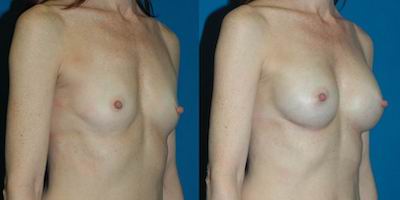
Subtler
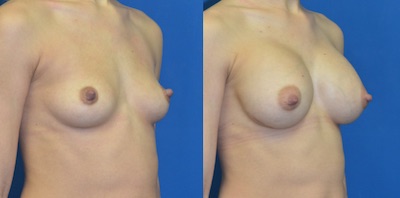
Fuller
What types of augmentation are available?
The two types of breast implants available on the market today are saline or silicone filled. Each type has a silicone shell or covering. The silicone implants currently in use are made of a cohesive gel, and are commonly referred to as “gummies”. This is because if you were to remove the shell and cut it into pieces, they will hold their shape. This is in contrast to the older silicone implant that were made of silicone that did not hold its shape and often had oils mixed in that could leak through the shell. Extensive research into their safety and performance was completed before approval to ensure that all implant material would be contained within the shell, eliminating many of the complication women experienced with the implants previously available.
The principal advantage to silicone implants over saline is that the breast has a more natural 'feel', and there is less visible implant wrinkling. They also will not deflate in the instance that the shell is damaged either by impact or over time.
A third option exists for patients interested in a very natural appearing breast augmentation. Your own fat can be removed during a liposuction procedure and transferred into your breasts. A lipo-augmentation procedure can typically achieve about a one cup size increase in breast volume. This is generally not an option for patients who have very small breasts as there needs to be tissue to graft into. For patients with larger breasts, more potential increase in size is possible. Likewise, you must have a significant amount of tissue to transfer. Dr. Burnett can help you determine what is attainable for your individual shape.
How do I decide if I want high profile implants?
There are five different profiles or shapes available. Low profile implants are wider and have less projection for a given implant volume. The main factors that determine which profile is best for you are how much volume you want to add, the width of your natural breast and what “look” you are trying to achieve.
The higher profile implants have a less natural, more rounded appearance. Aside from what type of look you prefer, the width of your natural breast must be factored in; therefore, Dr. Burnett will take precise measurements at your consultation. Using that measurement in conjunction with the amount of size increase you are interested in and your preference for breast shape, she will help you choose an implant that best fits you.

Where are the incisions placed?
There are three commonly performed incisions for breast augmentation surgery. These are: infra-mammary (at the bottom of the breast), peri-areolar (at the junction between the darker areolar skin and the lighter breast skin, along the lower border of the areola) and axillary (through the armpit). Each of these incisions has advantages and disadvantages.
The infra-mammary incision is by far the most common. It is placed at the lower border of the breast where it meet the chest wall. Dr. Burnett prefers to place it slightly higher so it is better concealed beneath a bra or bikini top.
The peri-areolar incision is also only visible when you are unclothed. It generally is less noticeable (especially early in the healing process) because it is placed along a line of natural color change. However, the size of your areola can limit the volume of silicone implants that can be placed. Peri-areolar incisions can be used for saline implants and for small silicone implants (less than about 300 cc). Larger silicone implants require an infra-mammary incision. Both inframammary and peri-areolar incision can be re-used for revisions or be incorporated into a breast lift procedure, if that is part of your plan now or in the future.
Axillary incisions are placed within the skin of the armpit. While they occasionally heal well enough to look like a natural skin crease, the scar is visible when the arms are raised. Since the incision is not located on the breast, an endoscopic technique is used to develop the pocket for implant placement. Larger silicone implants are difficult to place through this incision as they need to fit through both a small opening and a tunnel that is created between the armpit and the breast. Another disadvantage of axillary incisions is that they can’t be reused for revisions or incorporated into a breast lift.
All incisions tend to soften and lighten in color over time, often making them difficult to see, even when unclothed. The length of the scar varies based on the size and type of the implant. Generally, very short scars (2-3 cm) are used to place small silicone implants and for saline implants, which are filled after they are placed. Longer scars (4-5 cm) are used to place larger silicone implants.
Should I have my implants placed above or below the muscle?
Both silicone and saline implants can be placed either under (sub-muscular) or over the chest muscles (sub-glandular) depending on your anatomy and the 'look' that you are interested in achieving.
![]()
![]()
Muscle and implant relationship - the implant can be placed over the muscle (left) or under the muscle (right)
While sub-glandular placement is sometimes advertised as having a very short recovery without activity restrictions, Dr. Burnett generally recommends placement under the muscle for several reasons. One is that most women who want implants have a fairly small amount of breast tissue to begin with. Placing the implants below the muscle adds another layer of coverage, providing for a more natural appearance by smoothing the transition at the edges of the implant. Sub-muscular placement also tends to minimize rippling of the implant edges that sometimes occur, especially with saline. Additionally, the muscle provides natural support to the breast acting like an “internal bra”. That helps to maintain breast shape over time and prevent or delay drooping of the breast.
The main disadvantage of sub-muscular placement is animation. That is abnormal appearing movement with chest muscle use. Generally that is only noticeable when strongly contracting the pectoral muscles such as while doing chest presses or pushups. The advantages outweigh that disadvantage in most cases.
I have seen some photos with cleavage and some with spacing between the breasts. Can I choose?
The amount of space between your breasts is determined by where your chest muscles attach to your chest wall. You can easily check this by gently pressing your breasts toward each other. This will show you the outline of your natural breast tissue. Over releasing the muscle to narrow the space can give the appearance of one wide breast across the whole chest. That complication is called symmastia, which is very difficult to correct.
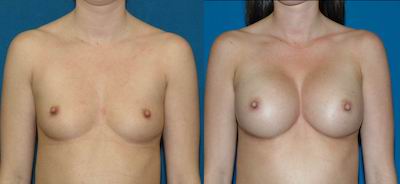
Narrow
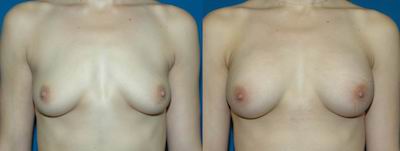
Wide
My breasts are really saggy. Is it true that I can avoid having a lift by getting large implants?
Some degree of skin excess can be taken up by the implant, but if you have a significant amount of breast tissue below the natural fold, you will need a breast lift in order to achieve a nice shape. Be cautious if you are told that placing a large implant or placing it over the muscle will take up the extra skin. Check to make sure the practitioner you are speaking with actually offers both augmentations and breast lifts.
We frequently see patients who have been told they won’t need a lift with large enough implants. They often end up with implants that they are so large that they have gone from seeking implants to feel more feminine or fill out clothing to being self-conscious because they are too large or being unable to fit into the styles they had wanted to wear. Worse, they are still unhappy with the overall shape.
Dr. Burnett can determine whether or not a breast lift is indicated in your case and what type is recommended according to your exam.
What is the recovery process after breast augmentation surgery?
After a breast augmentation procedure, you will be prescribed pain medication to keep you comfortable. Most breast augmentation patients are back to full-time non-strenuous work within one week although individual healing experiences may vary. For several weeks after the surgery, you will wear a special bra that keeps the implants positioned properly and aids in the healing process. You may resume light, non-impact exercise (walking, stretching) a few days after surgery, but must avoid use of your chest muscles for strength for the first four weeks.
I heard there was a recall in July 2019 of certain implants. What should I know about that?
Yes, Dr. Burnett does not and has not ever used the BIOCELL Textured Breast Implants involved in the recall.
The recall was in response to recent data linking breast implant associated anaplastic large cell lymphoma (BIA ALCL) with a specific subgroup of implants. It was voluntary: i.e., the company chose to remove the implants from the market as a precautionary measure without a mandate from the FDA, but at their suggestion.
Unlike a typical recall, they are not suggesting removal of those implants from patients who have them, but rather at choosing not to allow more patients to receive them going forward.
BIA-ALCL is not breast cancer - it is a type of lymphoma (immune system cancer). BIA-ALCL is found in the scar tissue and fluid near the implant, though in some cases, it can spread further. Further spread was mainly seen with the initial cases before we were aware of how to recognize, diagnose and treat it.
The type of implants involved are Allergan implants that have a certain type of texturing on the surface called Biocell. While widely used in other countries, they represent less than 5% of the implants used in the US. Most of those have been for breast reconstruction, though some surgeons do use them for augmentation. In the case of augmentation, they are usually reserved for patients who opt for implants placed on top of the muscle (subglandular).
Since the first cases of BIA ALCL were diagnosed only as recently as 2011, and the total number of cases worldwide is small, the true incidence is not yet known. To put it into perspective, though, 1.6M patients underwent augmentation last year alone and the total number of cases reported worldwide thus far is less than 600. These have largely been outside of the US.
Most patients who have been diagnosed have had their implants for several years with the most common timing of diagnosis being 8-9 years later. Generally, the patient first notices swelling near one of their implants or see that one seems to be enlarging. This is the development of a fluid collection within the capsule (scar tissue). The fluid is sampled and sent to a lab for diagnosis. In most patients, BIA-ALCL is treated successfully with surgery to remove the implant and the scar tissue surrounding the implant.
As with any implanted device, it is good to keep a record of the device manufacturer, unique device identifier, and implant model name. You should receive this information on a patient device card from your surgeon. If you already have implants and do not have the information, this can often be obtained by contacting your surgeon, the facility where the surgery took place or though contacting the implant companies directly and having them check their registry.
Again, as of July 2019, the FDA does not recommend removal of breast implants in patients who have no symptoms due to the low risk of developing BIA-ALCL.
How do I know if I am a good candidate for surgery?
If you are considering breast augmentation procedure we encourage you to complete this Surgical Consultation Intake Form. Dr. Burnett will tell you whether you are a suitable candidate for a breast augmentation procedure and inform you of the potential risks of the procedure. There is a great variety in breast shapes and features and each breast implant procedure must be custom tailored for the patient to get the best possible result. You will also have a chance to view before and after photo albums of patients who have undergone procedures similar to what you are considering.
Breast Augmentation Photo Gallery
You may wish to browse through the gallery of representative before and after breast augmentation images. Click on any of the thumbnails to enter the slide show. The text accompanying the photos describes the details of the procedures performed.
*Individual results may vary.


